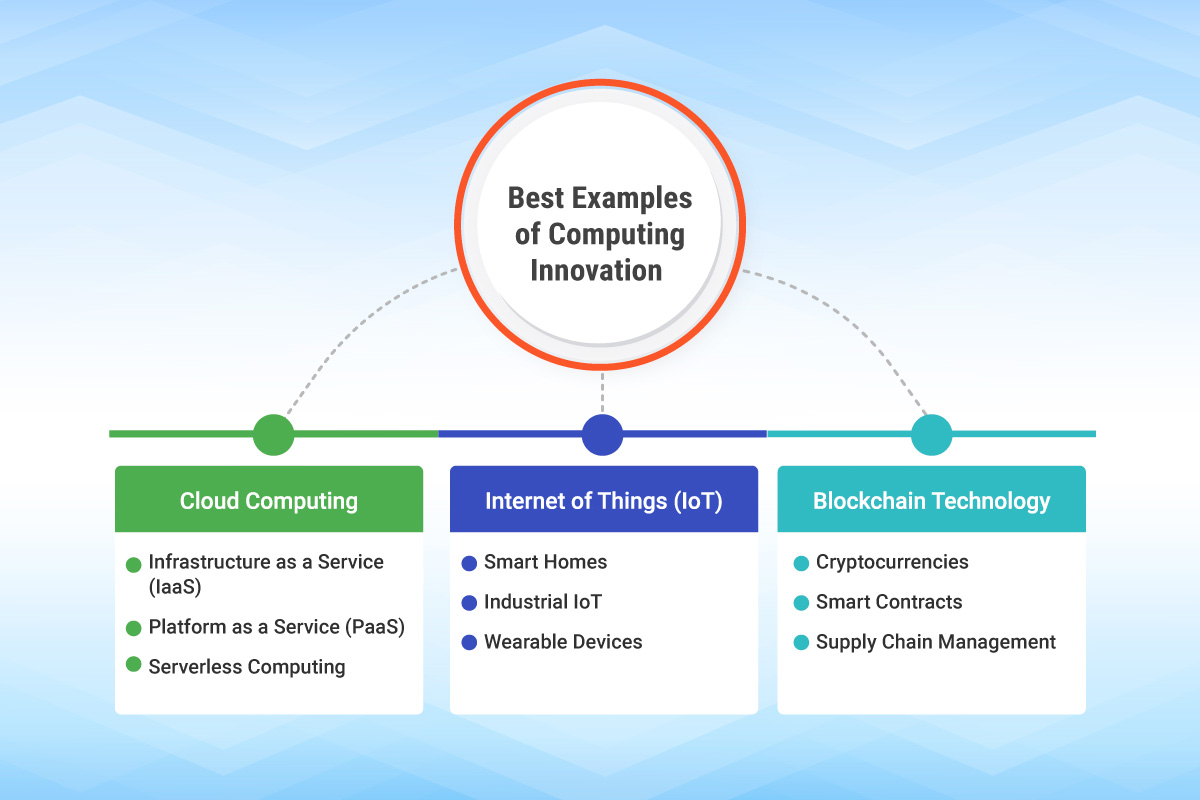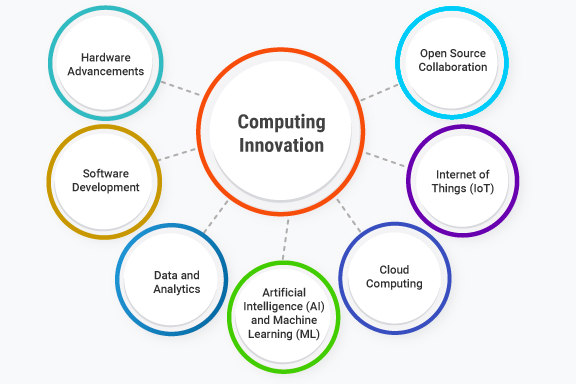Table of Contents
What is Computing Innovation?
Computing innovation is defined as the creation and application of novel ideas, technologies, and approaches within the field of computing. It involves developing new algorithms, software systems, hardware architectures, and computational methodologies to solve complex problems, improve efficiency, and drive advancements in various domains.
The importance of computing innovation can be seen in several key aspects:
- Technological Advancement: Computing innovation fuels technology innovation across multiple industries. It drives the development of more powerful processors, advanced software applications, and cutting-edge hardware systems. Computing innovations have led to significant advancements in areas such as artificial intelligence, data analytics, virtual reality, cloud computing, and cybersecurity.
- Problem Solving and Optimization: Computing innovation enables the development of new approaches and algorithms to solve complex problems. It provides tools and techniques to optimize processes, analyze data, and make informed decisions. Computing innovations have been instrumental in solving challenges in fields like healthcare, finance, logistics, manufacturing, and scientific research.
- Digital Transformation: Computing innovation is a key driver of digital transformation. It enables organizations to leverage technology innovation to automate processes, enhance productivity, and deliver digital services. Computing innovations such as mobile applications, cloud computing platforms, and Internet of Things (IoT) devices have transformed the way businesses operate, interact with customers, and manage their operations.
- Economic Growth and Competitiveness: Computing innovation plays a vital role in driving economic growth and enhancing competitiveness. It creates new business opportunities, job roles, and industries. Countries and organizations that invest in computing innovation can gain a competitive advantage, attract investment, and stimulate economic development. Computing innovation also fosters entrepreneurship and the creation of startups focused on technological advancements.
- Accessibility and Inclusivity: Computing innovation has made technology more accessible and inclusive. User-friendly interfaces, mobile devices, and affordable computing systems have democratized access to information, services, and opportunities. Computing innovations have also contributed to assistive technologies for individuals with disabilities, making technology more inclusive and enabling greater participation in various aspects of life.
- Social Impact: Computing innovation has a profound social impact, improving social innovation such as the quality of life and addressing societal challenges. It has transformed education by enabling online learning platforms, personalized learning experiences, and educational software. Computing innovations also contribute to healthcare improvements, environmental sustainability, disaster management, and social connectivity through social media platforms and communication technologies.
- Scientific and Technological Research: Computing innovation plays a crucial role in advancing scientific research and discovery. High-performance computing, computational modeling, and data analysis techniques enable researchers to process large amounts of data, simulate complex phenomena, and accelerate scientific breakthroughs in fields such as astronomy, genomics, climate modeling, and drug discovery.
Here are the 7 key components that drive computing innovation:
1. Hardware Advancements
Advances in hardware technologies, such as processors, memory, storage devices, and networking infrastructure, play a critical role in computing innovation. More powerful and efficient hardware enables faster computations, larger data processing capabilities, and the development of new computing architectures.
2. Software Development
Software development is a crucial component of computing innovation. It involves creating innovative algorithms, programming languages, frameworks, and software tools that enable new functionalities, enhance performance, and improve user experiences. Software development drives innovation in areas like artificial intelligence, data analytics, cybersecurity, and software engineering practices.
3. Artificial Intelligence (AI) and Machine Learning (ML)
AI and ML technologies are major drivers of computing innovation. These technologies enable computers to perform tasks that typically require human intelligence, such as natural language processing, image recognition, and decision-making. Advances in AI and ML algorithms, deep learning architectures, and training methodologies are pushing the boundaries of computing innovation and enabling intelligent systems and applications.
4. Data and Analytics
The availability and analysis of large volumes of data have fueled computing innovation. Advances in data collection, storage, and processing technologies, along with sophisticated analytics techniques, allow organizations to extract valuable insights, identify patterns, and make data-driven decisions. Computing innovation in data and analytics enables advancements in areas of technology innovation such as machine learning, data mining, predictive modeling, and business intelligence.
5. Cloud Computing
Cloud computing has transformed the way computing resources are provisioned, accessed, and utilized. It offers scalable and flexible computing infrastructure, storage, and services on demand. Cloud computing enables organizations to innovate rapidly, reduce infrastructure costs, and leverage powerful computing capabilities without heavy upfront investments. It also fosters collaboration, and data sharing, and enables the development of cloud-native applications and services.
6. Open Source Collaboration
Open-source software and collaboration play a significant role in driving computing innovation. Open-source communities facilitate knowledge sharing, collaboration, and the development of cutting-edge software solutions. Open-source projects and platforms provide a foundation for innovation, enabling developers to build upon existing technologies and create new applications and tools.
7. Internet of Things (IoT)
The IoT is a network of interconnected physical devices embedded with sensors, software, and connectivity. IoT drives computing innovation by collecting and analyzing vast amounts of data from sensors and devices. It enables the development of smart systems, automation, and the integration of physical and digital environments. IoT innovation is seen in applications ranging from smart homes and cities to industrial automation and healthcare monitoring.
Learn more: What is Technology Innovation?
Best Examples of Computing Innovation

There have been numerous innovations in computing that have transformed industries and the daily life of customers. Here are the key examples of computing innovation:
- Internet of Things (IoT): Computing innovation in IoT has led to the proliferation of connected devices and smart systems. Examples include:
a. Smart Homes: IoT-enabled devices like thermostats, security systems, and appliances enable remote control, automation, and energy efficiency in homes.
b. Industrial IoT: IoT technologies are used to monitor and optimize industrial processes, enabling predictive maintenance, supply chain optimization, and real-time monitoring of equipment.
c. Wearable Devices: Wearable technology innovations, such as fitness trackers and smartwatches, have enabled individuals to monitor their health, track physical activity, and receive personalized insights.
- Cloud Computing: Cloud computing has transformed the way computing resources are provisioned, accessed, and utilized. Innovations include:
a. Infrastructure as a Service (IaaS): Cloud providers like Amazon Web Services (AWS), Microsoft Azure, and Google Cloud Platform offer scalable and flexible infrastructure services, enabling organizations to rapidly deploy and scale their applications.
b. Platform as a Service (PaaS): PaaS solutions, such as Heroku and Google App Engine, provide developers with pre-configured platforms to build, deploy, and manage applications without worrying about the underlying infrastructure.
c. Serverless Computing: Serverless computing, exemplified by AWS Lambda and Microsoft Azure Functions, allows developers to focus on writing code without the need to manage servers, enabling more efficient and cost-effective application development.
- Blockchain Technology: Blockchain has brought innovation in decentralized and secure digital transactions. Examples include:
a. Cryptocurrencies: Bitcoin and other cryptocurrencies leverage blockchain technology to enable secure and transparent peer-to-peer transactions without the need for intermediaries.
b. Smart Contracts: Blockchain-based smart contracts automate the execution of contractual agreements, ensuring security, transparency, and immutability.
c. Supply Chain Management: Blockchain is used to create transparent and traceable supply chains, ensuring authenticity, reducing fraud, and improving efficiency in areas like food traceability and logistics.
These examples illustrate how computing innovation has driven transformative changes in various domains, enhancing efficiency, enabling new services, and improving user experiences. Computing innovation continues to evolve rapidly, creating exciting possibilities for the future.
Learn more: What is Process Innovation?
Top 10 Best Practices for Computing Innovation
When it comes to computing innovation, implementing best practices can enhance the chances of successful outcomes and avoid pitfalls. Here are the 10 best practices for computing innovation:
1. Foster an Innovation Culture: Create a culture of innovation that values and encourages innovation. Foster an environment where employees are empowered to explore new ideas, take calculated risks, and challenge the status quo. Establish channels for ideation, collaboration, and knowledge sharing.
2. Continuous Learning and Skill Development: Invest in ongoing learning and skill development programs for your team. Provide training opportunities, workshops, and access to resources to stay up-to-date with the latest advancements in computing technologies, methodologies, and tools. Encourage participation in conferences, industry events, and community forums.
3. User-Centric Approach: Place users and their needs at the center of computing innovation efforts. Conduct user research, engage in user testing, and gather customer feedback to understand their pain points, desires, and preferences. Incorporate user-centric design principles to develop intuitive, user-friendly solutions that solve real-world problems.
4. Agile and Iterative Approach: Adopt agile methodologies and iterative development processes to facilitate rapid experimentation, learning, and adaptation. Break down complex projects into smaller, manageable increments to deliver value quickly. Regularly review and refine strategies based on feedback, changing market dynamics, and emerging technologies.
5. Embrace Openness and Collaboration: Foster collaboration and partnerships with external stakeholders, including other organizations, research institutions, startups, and open-source communities. Embrace open innovation models that promote knowledge sharing and collaborative problem-solving to leverage diverse perspectives and expertise.
6. Data-Driven Decision Making: Utilize data and analytics to drive computing innovation. Collect and analyze relevant data to gain insights into user behavior, market trends, and performance metrics. Make informed decisions based on data-driven insights, and iterate based on continuous feedback loops.
7. Intellectual Property Protection: Understand the importance of intellectual property (IP) and establish processes to protect your innovations. Safeguard your ideas, inventions, and software through patents, copyrights, trademarks, or trade secrets. Develop a clear IP strategy that aligns with your business goals and mitigates potential risks.
8. Collaboration Between IT and Business Units: Foster collaboration and communication between IT teams and business units. Ensure alignment between technology initiatives and strategic business objectives. IT teams should have a deep understanding of the business context, customer needs, and industry trends to drive relevant and impactful computing innovation.
9. Regular Evaluation and Continuous Improvement: Continuously evaluate the impact and effectiveness of your computing innovation efforts. Monitor key performance indicators (KPIs), gather feedback from customers and stakeholders, and conduct periodic reviews to identify areas for improvement. Use the insights gained to refine strategies, pivot if necessary, and continuously enhance computing innovation practices.
10. Experimentation and Risk-Taking: Encourage a culture of experimentation and risk-taking. Embrace a fail-fast mentality that views failures as learning opportunities. Provide the necessary resources, support, and infrastructure to enable employees to experiment, try new approaches, and explore innovative ideas.
By adopting these best practices, organizations can foster a culture of innovation, drive successful computing innovation initiatives, and stay at the forefront of technology innovation.
Learn more: What is Innovation Framework?
Most Recent Blogs
Explore the latest innovation insights and trends with our recent blog posts.










